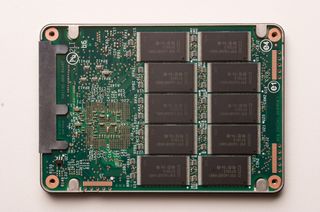IDF 2008: Intel firms flash drive plans
Intel claims highest performance, lowest power SSDs.

What is Intel's SSD lineup?
Intel's Flash-based hard drive replacements come in two versions. The X18-M and X25-M mainstream solid-state drives for notebooks and desktops are 1.8in and 2.5in drives respectively, both with the choice of 80GB or 160GB capacity.
What about servers?
Intel is sticking with single-layer cells for the 2.5in X25-E Extreme SSD for servers, which reduces the capacity to 32GB and 64GB but more than doubles the write speed, from 70MBps to 170MBps.
If you care about Input/Output Operations Per Second for making data access as fast as possible, going to SSD will take less space Intel claims to deliver 50x more IOPS per square foot uses less power and needs less cooling than hard drives, taking a strain off your data centre infrastructure.
When will they be on sale?
Samples of the 80GB and 32GB models are going to device manufacturers now and will be available by the end of September. Samples of the 160GB and 64GB models will start in Q4 and be available in the first quarter of 2009.
Get the ITPro. daily newsletter
Receive our latest news, industry updates, featured resources and more. Sign up today to receive our FREE report on AI cyber crime & security - newly updated for 2024.
Why should you care about Intel's solid-state drives?
Hard drives have much higher capacities than flash drives. Increasing the capacity of SSDs means either making much larger single-layer flash cells, or combining smaller cells into multi-layer cells (MLC). Unfortunately, this degrades performance and means the flash doesn't last as long.
Intel claims to have dealt with the MLC problem by using "compute quality" NAND that meets the Open NAND Flash Interface (ONFi) and by developing its own controller with a 10-channel parallel architecture that removes unnecessary writes and spreads data evenly over the drive.
According to Intel SSD product line manager Kishore Rao, "advanced wear levelling algorithms are just like changing the tyres on your car" so that one area of flash doesn't wear out sooner than the rest. The controller also has a write amplification factor an order of magnitude lower than the competition: "when you write from the PC to the hard drive, a certain amount of data comes from the host PC but a lot more gets written the higher than write amplification factor the worse it is for reliability."
Rao says that this adds up to a five-year life for the drives, assuming you write 20GB of data a day. "That would be a heavy data user, and we can actually go up to 100GB per day."
Intel is claiming an extra 30 minutes of battery life on the average six-cell laptop battery, and significantly better performance. Compared to a 5400rpm hard drive, opening and resizing a mix of photo and video files takes around 30 seconds rather than 1 minute 34 seconds. Using the Iometer benchmarking software, the Intel SSD delivered 1200 IOPS compared to 500 IOPS from a competitor and just 250 from a 5400rpm hard drive.
How much will they cost?
Intel promises an official price within 30 days, which is when it starts production of the first SSDs. Kishore Rao claims Intel's "ability to produce a multi-level cell drive for the notebook puts us in a class of very few drives that are qualified for notebooks and you'll see very competitive and value-oriented pricing for that class." HP has said it will offer Intel SSDs in its new EliteBook models including the 2530p ultraportable, 2730p tablet and 6930p mobile workstation which runs for 24 hours on a 12-cell battery with an SSD for an extra US$800 to US$900 (420 to 470).
They say
"We have a deep understanding of flash, we have a deep understanding of computing and we developed a controller from the ground up, spending tens of man years on firmware development . When you're going into the computing environment it's a whole different game from providing the large block transfers that USB [sticks] are handling today."
We say
SSDs have taken a long time to reach the market, prices have stayed high and there have been questions about how long flash will last and whether it will really deliver extra performance and battery life.
If Intel's controller is as good as the company claims, it will mean high-capacity drives at lower prices that actually deliver the benefits of flash storage.
Mary is a freelance business technology journalist who has written for the likes of ITPro, CIO, ZDNet, TechRepublic, The New Stack, The Register, and many other online titles, as well as national publications like the Guardian and Financial Times. She has also held editor positions at AOL’s online technology channel, PC Plus, IT Expert, and Program Now. In her career spanning more than three decades, the Oxford University-educated journalist has seen and covered the development of the technology industry through many of its most significant stages.
Mary has experience in almost all areas of technology but specialises in all things Microsoft and has written two books on Windows 8. She also has extensive expertise in consumer hardware and cloud services - mobile phones to mainframes. Aside from reporting on the latest technology news and trends, and developing whitepapers for a range of industry clients, Mary also writes short technology mysteries and publishes them through Amazon.





